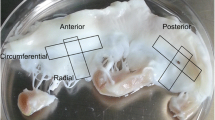Summary.
Background:
The ideal scaffold material for tissue engineered heart valves is discussed controversially. We evaluated acellularized xenogenic matrix constructs with and without seeding with autologous vascular cells in the pulmonary circulation in a sheep model.
Methods:
Porcine pulmonary valve conduits (n=16) were acellularized by trypsin/ EDTA incubation. Autologous myofibroblasts and endothelial cells were harvested from carotid arteries; xenogenic valve conduits (n=10) were repopulated with these autologous cells resulting in uniform cellular restitution of the pulmonary valve conduit surface. Using this method, we implanted autologous cell/xenogenic matrix constructs (XB) in ten animals. In six control animals acellularized/xenogenic matrix constructs (XA) were implanted. In each animal, cardiopulmonary bypass was used to resect the pulmonary valve and replace it with the xenogenic pulmonary valve conduits. The animals were killed after 6, 9 or 12 months. The explanted valves were examined histologically and biochemically.
Results:
After explantation XB showed severe cusp degeneration, which resulted in severe valvular regurgitation. In comparison, XA appeared macroscopically normal with preserved valvular function. The surface of XB were covered with an incomplete endothelial multilayer. The extracellular matrix (ECM) of XB showed pathological amounts of collagenous and elastic fibers as well as proteoglycan content combined with an increase cellularity. The XA were completely repopulated by an endothelial cell monolayer; the ECM was repopulated with a myofibroblast population comparable to native ovine heart valve tissue.
Conclusions:
Approaches to heart valve engineering based on acellularized/xenogenic matrices provide promising results and will hopefully led to the “ideal” valve substitute in clinical heart valve replacement.
Zusammenfassung.
Zielsetzung:
Die ideale Matrix für bioartifiziell hergestellte Herzklappen mittels „Tissue engineering“ ist bis heute nicht eindeutig definiert. In dieser Studie evaluierten wir eine xenogen azellularisierte Matrix als Basis für artifiziell hergestellte Herzklappen mit und ohne In-vitro-Rebesiedelung mit autologen Myofibroblasten und Endothelzellen im wachsenden Tiermodell bei Morinoschafen.
Material und Methoden:
Porcine Pulmonalklappenkonduits (n=16) wurden mit Trypsin/EDTA azellularisiert. Autologe Myofibroblasten und Endothelzellen aus Segmenten der A. carotis communis gewonnen wurden zur In-vitro-Rebesiedlung xenogener azellularisierter Klappenkonduits (n=10) verwendet. Die orthotope Implantation der in-vitro rebesiedelten (n=10, XB) und xenogenen azellularisierten Pulmonalklappenkonduits (n=6, XA) folgte mit Hilfe der extrakorporalen Zirkulation. Das Gewicht der Tiere war 15,7±2,4 kg. Nach 6, 9 bzw. 12 Monaten wurden die implantierten Pulmonalklappenkonduits explantiert und histologisch aufgearbeitet.
Resultate:
Die in vitro besiedelten Pulmonalklappen zeigten degenerierte Klappensegel einhergehend mit Verlust der Klappenschlussfähigkeit. Im Vergleich dazu waren die XA-Klappenkonstrukte nach 6 und 12 Monaten makroskopisch unauffällig und funktionstüchtig. Histologisch zeigte sich bei den in vitro besiedelten Klappenkonstrukten eine pathologisch veränderte Zusammensetzung der Extrazellularmatrix (EZM) in Kombination mit einer erhöhten Zellularität sowie einer inhomogenen Besiedelung mit Endothelzellen. Die XA-Klappenkonstrukte zeigten eine normal aufgebaute EZM die mit herzklappenspezifischen Zellen besiedelt war sowie einem kontinuierlichen endothelialen Monolayer.
Schlussfolgerung:
Die azellularisierte xenogene Matrix ist eine viel versprechende Biomatrix mit guten funktionellen Ergebnissen und somit ein mögliches Grundgerüst zur Herstellung von artifiziellen Herzklappen mittels „Tissue Engineering“.
Similar content being viewed by others
Author information
Authors and Affiliations
Corresponding author
Additional information
Teile dieser Studie wurden auf der 68. Jahrestagung der Deutschen Gesellschaft für Kardiologie—Herz- und Kreislaufforschung im April 2002 in Mannheim vorgestellt
Rights and permissions
About this article
Cite this article
Leyh, R., Wilhelmi, M., Haverich, A. et al. Eine azellularisierte xenogene Matrix als Basis einer artifiziell hergestellten Herzklappe mittels „Tissue engineering“. Z Kardiol 92, 938–946 (2003). https://doi.org/10.1007/s00392-003-0978-4
Received:
Accepted:
Issue Date:
DOI: https://doi.org/10.1007/s00392-003-0978-4




